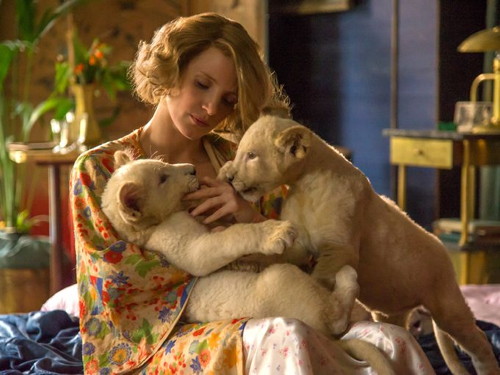The Zookeeper’s Wife: Kielbasa and Cabbage Recipe 🥁🥁🥁🥁
/Year Released: 2017
Directed by: Niki Caro
Starring: Jessica Chastain, Johan Heldenbergh, Daniel Bruhl
(PG-13, 126 min.)
Genre: Drama

“You can never tell who your enemies are, or who to trust. Maybe that’s why I love animals so much. You look in their eyes and you know exactly what’s in their hearts. “ Antonia Zabinska
Life of Pi meets Schindler’s List. When war devastates their Warsaw Zoo, one courageous woman and her husband come up with another plan. They will shelter other creatures, the Jews detained in the infamous Warsaw Ghetto.
Some critics have faulted the film for avoiding the more sordid details of the Nazi takeover of Warsaw, or demeaned the many shots of the lovely animals Antonia Zabrinska (Jessica Chastain) cares for with a motherly touch.
Critic Peter Holden of The New York Times dismisses it as “Schindler’s List with pets, “ proclaiming it too mild-mannered and sanitized.”
This critic begs to differ. We have seen so many documentaries and films rife with all the sordid cruelty and evil of the Holocaust that another such approach becomes one of many. The innocent animals add another dimension in The Zookeeper's Wife.
We bond with those creatures in the early scenes. This zoo is not just business for Antonia and Jan Zabrinski (Johan Heldenberg). The animals are part of their family. Two adorable orphan lion cubs sleep with their son Ryszard (Timothy Radford). Antonia begins her rounds of the zoo each morning with an unusual assistant, a young camel who runs alongside her as she greets each creature individually, almost like mother waking up her brood. We see the depths of their mutual trust when Antonia saves a choking baby elephant under the watchful eyes of its 3-ton mama swaying nervously above her.
When bombs randomly kill and maim so many creatures we feel it keenly, but the later intentional slaughter of the remaining animals seems even more cruel. Nor do the facile works of Lutz Heck (Daniel Bruhl), head of the Berlin Zoo, ease the pain. The animals will not make it through the winter, since the care and feeding the occupying Nazi army is now the priority. The animals are simply collateral damage. Heck does little to hide his pleasure as he personally shoots a beautiful eagle, and then casually orders its body stuffed. Later we see it showcased in his Warsaw office.
Lutz Heck has external sophistication and manners, a smiling charm and admiration for the lovely Antonia, not unlike the SS Colonel Hans in Gloomy Sunday, who was also smitten with a local beauty in occupied Hungary. Why is a smiling villain somehow more loathsome than a grimacing one?
The cruelties visited on the Polish Jews are not front and center in the film. The rape of a young girl is seen more in the aftermath; her ripped clothing and vacant stare more poignant with the actual violence being on film. Similarly, when we see the Ghetto inhabitants board trains, the guards taking their carefully packed suitcases from them and discarding them in a haphazard pile like so much rubbish, we know the people will be treated as such. The audience needs no replay of gas chambers disguised as showers to hint at their gruesome fate. Again, these hints of evil are possibly more effective than outright displays of it.
The Zabinskis cannot save them all, but each life spared counts. And the academic Dr. Zabinski is not afraid to become a pig farmer and immerse himself and those he saves in garbage if that would free them.
Antonia and Jan were determined to save as many people as they could, and by any ruse possible. Persuading the Nazis to let them raise pigs for meat for German soldiers gave Jan an excuse to drive his truck into the ghetto: On the pretense of gathering garbage for hog feed, he smuggled food and money in and people out. Both he and Antonina always kept cyanide capsules at the ready, in case they were caught. –Barbara Hoffman
Do not miss this fine film based on a true story. We need more like this that celebrate quiet courage and resolve.
–Kathy Borich

Trailer
Film-Loving Foodie
In order to stay at their zoo, even after all the animals have been taken away or slaughtered for their meat to feed the Nazi soldiers, Antonia and her husband Jan turn their operation into a pig farm. They pork will easily feed the soldiers, and the zookeepers are allowed to stay in Warsaw. But most important, this provides great cover for their plan to save many of the Jews from the infamous Warsaw Ghetto.
Let’s use this pork to make a simple and delicious meal:
"Cabbage cooked in bacon drippings and seasoned with garlic, red pepper flakes and caraway seeds makes a cozy nest for smoked Polish-style sausage in this homey, hearty, and satisfying supper."
Kielbasa and Cabbage
"This smoked Polish sausage dish is great for company, but quick enough for a weeknight! It is super good and easy, and can be prepared well in advance. Complete your meal by adding a baked potato, fruit salad, and bread."
Ingredients
6 slices bacon
1/4 cup water
2 tablespoons white sugar
1 onion, chopped
2 teaspoons minced garlic
1/4 teaspoon crushed red pepper flakes
1/4 teaspoon seasoning salt
3 teaspoons caraway seed
1 large head cabbage, cut into small wedges
1 pound Polish kielbasa
Directions
In a large skillet, fry bacon over medium high heat until browned, turning once. Remove bacon from pan, reserving drippings, and place on paper towels.
Stir water, sugar, onions, garlic, red pepper flakes, seasoned salt, and caraway seeds into drippings. Add cabbage, and gently stir. Cover, and cook over medium heat for 10 to 15 minutes.
Add kielbasa to the pan. Cook, covered, for an additional 10 to 15 minutes. Crumble bacon over top, and serve hot.















